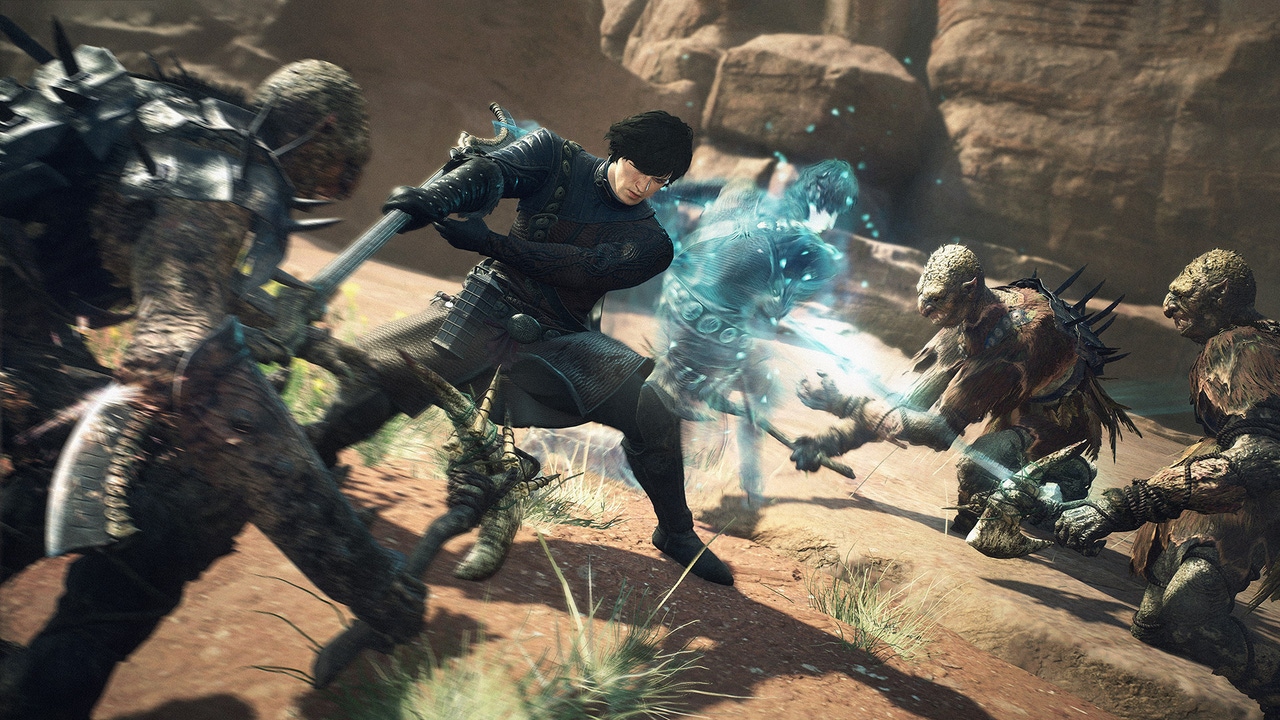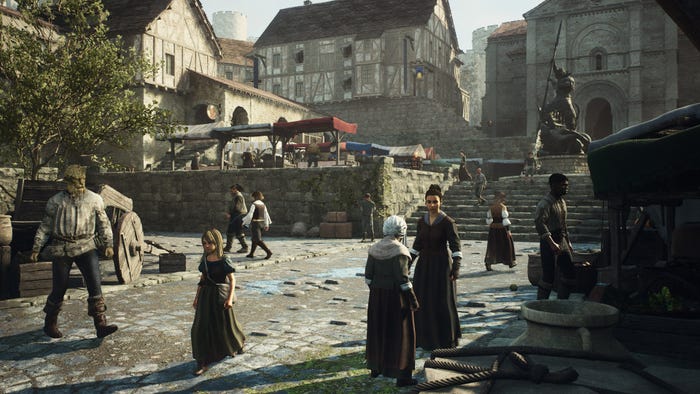Trending
Opinion: How will Project 2025 impact game developers?
The Heritage Foundation's manifesto for the possible next administration could do great harm to many, including large portions of the game development community.

Capcom's Dragon's Dogma 2 is the long-awaited follow-up to the 2012 action RPG that saw the developer take its first step into the open-world RPG genre. In the time since its release, the original Dragon's Dogma went from a modest cult classic to a genre favorite among RPG fans for its unusual yet still satisfying approach to a single-player adventure within a connected online world.
That “connected online world” was brought together through "Pawns"—customizable party members that can be shared through an online portal with other players. Pawns sent out into the online world would return having “learned” from their experiences, and in Dragon’s Dogma 2, what kind of information they can learn and offer the player has been elevated to a whole new level.
With mere weeks until Dragon’s Dogma 2 hits the market, we spoke with game director Hideaki Itsuno about returning for the sequel and how the time away from the franchise led to a bigger and more ambitious follow-up.
Dragon's Dogma 2 is a stand-alone sequel that ups the scale to focus on a conflict between the kingdoms of Vermund and Battahi—two nations built up from different cultures and species of characters. Playing as a character known as the Arisen, they must navigate a world in conflict with their party made up of Pawns.
The sequel sticks very close to the original's structure of a swords-and-sorcery epic, with the group taking on quests, fighting monsters, and protecting a kingdom in peril. That standard fantasy fare was elevated by the Pawn system, and it proved a unique way of creating characters that could organically acquire knowledge to navigate a dangerous world.
The 2012 action RPG took some time to find its audience, and thanks to ports to other platforms, it eventually became a best-seller. During a GDC 2013 talk following Dragon's Dogma's release, Itsuno showed design documents for the original vision for the game—which featured a world that was more than twice the size and even had a complex endgame where the Arisen's journey would take them to the moon.
While the talk initially seemed it might point to what's next for the series, Itsuno explained to us that sequel and its vision were more informed by the response to the 2012 game than any of the early docs.

Image via Capcom.
"For the sequel, we looked at what worked with the finished game rather than what the proposed original design plans were back then," said Itsuno. “We realized we needed two nations with different cultures within the game, and by having two different cultures, we would have two different communities with different ideas and knowledge. That was an idea from the original game, and we finally put that in Dragon's Dogma 2.”
“We largely built this game the same way as the first, by building our map and designing the quests and experiences within it from there."
Creating two in-game sources of “knowledge” for Pawns to draw from would become a deep part of the Dragon’s Dogma 2 experience.
With bigger stakes and a larger world to explore than in the original—up to four times greater in size—the developers focused more on the storytelling and the many characters of the sequel. While encountering townsfolk in each region, you can listen to their banter with others and learn valuable intel and insights that can help on quests or investigations.
In one such early quest, players are tasked with preventing the assassination of a popular Battahi leader. To do so, they must survey suspected characters in the area and listen to banter that may implicate or exonerate them.
Dragon's Dogma 2 also includes a complete compendium of info for every notable character you encounter in the game. It's a surprising addition that is very helpful for questing, but it also serves as an extension to the game's returning Pawn system—the original game's most significant innovation.
With the Pawns, players can select randomly generated or player-created characters to join their party—including the player's custom pawn. These characters come in various classes and have distinctive personalities and designs, giving them a sense of individuality.

Image via Capcom.
In addition to combat encounters, where the pawns can shout out tactics and suggestions to the player, the Pawns offer insight on locations and solutions to puzzles—all gained when shared in the online network. As Pawns travel to the realms of other players, they'll gain rewards and insight, which will benefit their creator and the main party—with some pawns even sharing jokes or quirky facts about other party leaders they've met.
It's a really intriguing and clever take on the party system, and given that Dragon's Dogma 2 is once again a single-player experience, the pawn system does a lot to make the game feel more alive as pawns made by other players will find themselves in your world. During the sequel's development, game director Hideaki Itsuno asked fellow developers to undertake an unusual exercise to offer more authenticity to the party's sense of unity.
"There's an interesting story behind how we made our world feel more natural in the sequel. So, on the development team, we have a very quiet member who barely speaks out, and for an exercise, I told him, ‘you are going to be the Arisen; you're going to bring three other people from the team and walk from the Capcom office to Osaka Castle,’ which is a roughly 30-minute walk," said the game director.
"I wanted them to take notes of all the conversations they heard along the way, and when they came back, and we looked over the notes, there were so many natural and interesting conversations that were heard during this exercise."
He told us that the anecdotes and moments from that walk informed Capcom’s approach for how NPCs in Dragon’s Dogma 2 express themselves in the game. "A lot of the conversations feel organic, and being able to hear [Pawns and other background figures] speak and learn valuable information was really powerful.”
“Gaining knowledge and understanding of the world around you from the people in it is a big part of Dragon's Dogma, and I'm glad we could flesh this out even further for Dragon's Dogma 2."
When reflecting on Dragon's Dogma, Itsuno stated that the original game was an anomaly back in 2012—an unusual action game released before the blockbuster popularity of challenging action titles like Elden Ring. Despite its mixed reception, it was one of the few games Itsuno immediately wanted to make a sequel to. “The original Dragon's Dogma was very special to me, and I had all these ideas for what I wanted to do with the sequel back then, which have changed a lot in the more than 10 years since that first game came out,” he said.
These days, Capcom has become a leading game developer with franchises like Monster Hunter, Resident Evil, and Street Fighter, and making a sequel to Dragon's Dogma is not such a tall order.
For Itsuno, who is Capcom's most seasoned action game director, he credits his varied experiences at the company for his insight into the genre—even if action games aren't really his thing.
"To be completely honest, action games aren't my favorite genre," Itsuno said. "But I do understand that I do them because the company finds some value in the games I'm making. The first game I ever worked on was the Quiz & Dragons: Capcom Quiz Game, and then I worked on Street Fighter and other fighting games for a few years.”
“That's where I really honed my craft in fighting games, which gave me the basics of how to make action games like Devil May Cry and Dragon's Dogma. That was because I had some really amazing people to learn from around me, many of whom worked on the classic games of Capcom."
"I don't think I would have been able to learn the skills and knowledge from anywhere else, and I wouldn't change that for anything in this world. I'm very fortunate in that regard, and I think that I had the chance to find those learnings because of my time at Capcom. It's been great, and I'm very excited for people to play Dragon's Dogma 2; it's been a long time since the first game."
In a way that makes Dragon’s Dogma 2 a reflection of Itsuno’s professional experience—just as he’s learned how to make action games through collaborating with his colleagues, players will learn how to play action games through the simulated social system of his new game.
You May Also Like